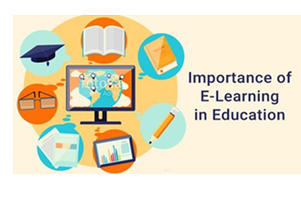Introduction
Learners nowadays desire content that is timely, self-paced, mobile and personalised. This criteria is met by online learning, which allows students to learn at their own pace and according to their preferences. Let's examine the benefits of online learning in more detail .

Fig1. Importance of E-Learning in Education
1. Everyone's Needs Are Met Through Online Learning
For everyone, the online learning approach is the ideal option. The way content is accessed, consumed, discussed, and shared has changed dramatically as a result of the digital revolution. Office workers and housewives alike can enrol in online educational courses at their leisure. Most people prefer to learn on evenings and weekends, depending on their availability and comfort .
2. There is no limit to how many times can take a lecture
With traditional classroom instruction, online learning allows you to view the materials an unlimited number of times. This is very important while revising for an exam. If you miss a lecture in traditional learning, you must prepare for that topic on your own; in eLearning, one can attend classes anytime you want.
3. Access to Up-To-Date Content
One of the most significant advantages of online learning is that it keeps you in step with modern learners. This allows the student to have access to the most up-to-date content anytime they desire .
4. Lessons Delivers Quickly
E-learning is a method of delivering lessons quickly. This manner of distribution has shorter delivery cycles than standard classroom education methods. This means that the amount of time it takes to learn is lowered by 25% to 60% compared to conventional learning. The following are some of the reasons why eLearning reduces learning time:
- Lessons begin quickly and are completed in one learning session. This allows training programmes to be implemented in a matter of weeks, if not days.
- Instead of learning at the same pace as the rest of the class, students can set their own pace.
- The learner does not have to travel to the training location, which saves time. You can study in the privacy of your own home.
- Students can focus on select and relevant sections of the learning content rather of studying everything. They can, for example, skip through sections they don't wish to learn .
5. Adaptability
E-learning facilitates the development and dissemination of new training, policies, concepts, and ideas. eLearning is a very quick manner of learning, whether it is for formal entertainment or education!
6. Reliability
E-learning allows educators to achieve a better level of coverage in order to transmit the information to their target audience in a consistent manner. With this learning method, all learners will receive the same type of training
7. Cost Savings
When compared to traditional learning methods, eLearning is less expensive. This price reduction is due to the fact that learning in this mode is quick and simple. In terms of trainers, travel, course materials, and lodging, a significant amount of training time is saved. This cost-effectiveness also contributes to an organization's profitability. Students are also relieved of paying for travel expenditures (e.g., lodging) when training takes place in another city/state and/or external learning materials while you study at home.
8. Productivity
E-Learning has a favourable impact on a company's bottom line. It makes it simple to comprehend and assimilate the information. It leads to higher certification, test, and other sorts of evaluation scores. A higher percentage of pupils earn the ‘pass' or ‘mastery' level. Increased ability to acquire and apply new methods or knowledge in work. Aid in the retention of information for a longer period of time .
9. Environmentally friendly
As eLearning is a paperless mode of instruction, it helps to safeguard the environment to a large extent. According to a study on eLearning courses, distance-based learning programmes used 90 percent less power and produced 85 percent less CO2 emissions than typical campus-based educational courses. There is no need to cut down forests to get paper using eLearning. As a result, eLearning is a very environmentally friendly means of learning.
Conclusion
E-Learning has grown in popularity and acceptance among students all around the world as a result of the numerous benefits it provides .

